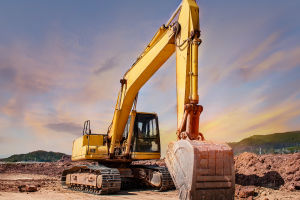Excavators are some of the most essential and versatile machines in the construction and excavation industries. Whether it's digging a trench for utilities or demolishing an old building, excavators play a crucial role in making construction projects run smoothly.
These heavy-duty machines are designed to perform a wide range of tasks with precision and efficiency, making them indispensable on construction sites worldwide.
What is an Excavator?
An excavator is a large, tracked or wheeled vehicle with a powerful arm and a bucket used primarily for digging and earth-moving tasks. The machine’s rotating platform allows it to move 360 degrees, making it incredibly efficient for tasks that require flexibility. Excavators are typically powered by hydraulic systems that enable the arm and bucket to move with incredible strength and precision. They come in various sizes, from mini-excavators for tight spaces to massive machines used in large-scale earth-moving projects.
Key Components of an Excavator
An excavator is made up of several key components that allow it to carry out different tasks:
1. The Boom: The long, hydraulic arm that extends from the machine and allows for digging, lifting, and reaching high areas.
2. The Stick: The part that connects the boom to the bucket or attachment, allowing the bucket to dig into the ground.
3. The Bucket: The most common attachment for an excavator, used for scooping and moving earth, debris, or materials.
4. The Swing Platform: The rotating section of the excavator that provides the machine with the ability to rotate 360 degrees for maximum flexibility.
5. Tracks or Wheels: Depending on the type of excavator, it may have tracks for stability and mobility in rough terrain or wheels for faster movement in urban areas.
Types of Excavators
Excavators come in various sizes and designs, each suited for specific tasks. Some common types include:
1. Crawler Excavators: These are the most common type, with large tracks that provide stability and allow the machine to operate on rough terrain.
2. Wheeled Excavators: Unlike crawler excavators, these machines have wheels that allow them to move quickly between different locations. They are best for urban construction sites or projects requiring fast mobility.
3. Mini Excavators: Smaller versions of standard excavators, designed for working in tight or confined spaces. These are often used for residential landscaping, small construction jobs, and utility work.
4. Long Reach Excavators: These machines have extended arms that allow them to dig deeper and reach further. They are commonly used for dredging, riverbank repairs, and deep trench work.
The Versatility of Excavators
Excavators are incredibly versatile and can be equipped with various attachments to perform tasks beyond simple digging. Some of the most common attachments include:
- Hydraulic Hammers: Used for breaking concrete, asphalt, and rock during demolition or roadwork.
- Grapples: Claw-like attachments that can grasp and move large objects like logs, debris, or scrap metal.
- Buckets: Different types of buckets can be attached for various tasks, such as digging, scooping, or grabbing materials. These buckets come in various sizes, from narrow buckets for precision work to large scoops for bulk earth-moving.
- Clamshell Buckets: Specially designed for digging in softer materials, such as sand or gravel, and are often used in dredging operations.
Augers: Used for drilling deep holes in the ground for foundations or poles.
Applications of Excavators in Construction
Excavators are used in a wide variety of construction tasks, including:
1. Digging Foundations: Excavators are essential for digging trenches and holes to lay the foundation of buildings, roads, and bridges.
2. Demolition: Excavators equipped with hydraulic hammers or other tools are often used to break down buildings, walls, and other structures.
3. Material Handling: Excavators can be used to lift and move materials, such as dirt, gravel, or construction debris, from one location to another.
4. Site Preparation: Excavators are often used to level and grade land before construction begins, ensuring a stable and level surface for building.
Excavators in Demolition
Excavators play a major role in the demolition industry, helping to tear down buildings, clear debris, and remove unwanted structures. With the right attachments, excavators can break concrete, cut steel, and even grab large chunks of debris. Their ability to rotate 360 degrees makes them highly efficient for clearing debris and removing materials from tight spaces. They are also equipped with specialized attachments like hydraulic breakers, grapples, and shears, all of which make demolition tasks faster and more efficient.
Why Excavators Are Essential
Excavators are indispensable in the construction and demolition industries. Their versatility, power, andefficiency allow them to perform a wide range of tasks, from digging and lifting to breaking and demolishing. Whether we're building a new home, digging a trench, or tearing down an old structure, an excavator is the tool for the job. Their ability to adapt to various tasks and environments makes them one of the most valuable pieces of equipment on any construction site.
So, next time we see an excavator on a job site, we'll know just how much power and precision it takes to complete those tough construction tasks.
Caterpillar 395 Excavator Loading Caterpillar 777 Dumpers - Sotiriadis Construction Works - 4k
Video by Mega Machines Channel


